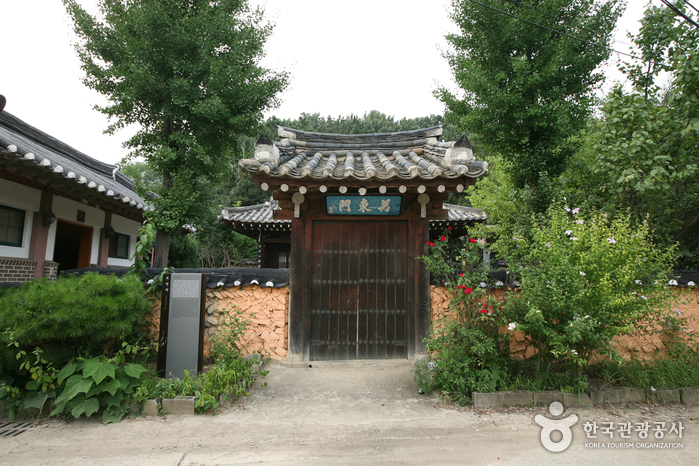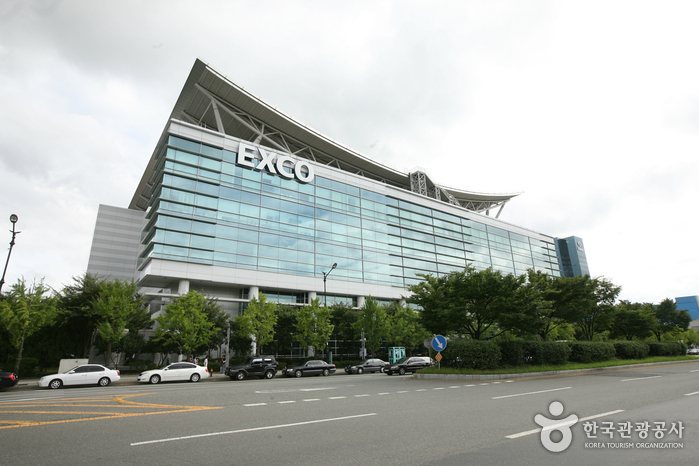Korean Traditional Culture Center (한국전통문화체험관)
8.2Km 2025-10-23
13-5 Dalgubeol-daero 527-gil, Suseong-gu, Daegu
+82-53-666-4930
Momyeongjae is an ancestral shrine built by the Dureung Doo clan to honor Doo Sa-chung, who had joined the Ming Dynasty's reinforcement troops during the Imjinwaeran (Japanese invasion of Korea, 1592) and later became naturalized in Joseon Dynasty. The name 'Momyeongjae' means 'longing for the Ming Dynasty,' expressing Doo Sa-chung's affection for his home country.
Doo Sa-chung, who was from Duling, China, went to Joseon under the command of General Li Rusong from the Ming Dynasty. Doo Sa-chung took the position titled Suryuk Jihoek Jusa and was responsible for selecting locations to establish a stronghold in consideration of the terrain. As a senior adviser to Li Rusong, he closely discussed strategies and tactics with the Joseon army as well.
When the war was over, Doo Sa-chung returned to China but went to Joseon again during the Jeongyujaeran (Japanese invasion of Korea, 1597). He brought his two sons -- Doo San and Doo Il-geon -- along with his brother-in-law, Admiral Chen Lin. When the war was over, Doo Sa-chung and his two sons naturalized in Joseon. The government of Joseon granted him land, which is the current Gyeongsang Gamyeong Park area.
When the Gyeongsang Gamyeong (Gyeongsang provincial office) was relocated to this area, Doo Sa-chung offered his land to the government and moved to Gyesan-dong.
Longing for his wife and brothers he had left in China, he moved again to a village near Daedeoksan Mountain (then Choejeongsan Mountain) and named the area Daemyeong-dong (meaning the Great Ming). He built a platform and on the first day of every month, he would bow in the direction of the Forbidden City in China, where the Emperor of the Ming Dynasty resided.
Momyeongjae is built on a rectangular plot and faces south. It features a hip-and-gable roof with double-layer eaves and has four rooms in the front and two rooms on the side. The daecheongmaru (wooden floor hall) has two ondol (floor heated) rooms on each of its side, with a half-sized bay at the front. Momyeongjae exemplifies the early 20th-century ancestral shrine style commonly found in the Daegu area.
The building was originally constructed in 1912 when Doo Sa-chung’s descendants moved wooden materials from the dismantled Gyeongsangaeksa (local government building) and used them to build Momyeongjae in front of Doo Sa-chung's tomb. The shrine was later renovated in 1966 as it was in poor condition.
Momyeongjae is one of the first destinations visited by Chinese tourists in Daegu. It was recently renovated as part of a redevelopment project. The Korean Traditional Culture Center opened nearby, where visitors can experience tea ceremonies, hanbok (traditional Korean clothing), archery, and cooking dishes based on Donguibogam, a traditional Korean medical encyclopedia. Joining a program at the center will be a valuable experience.
Aritaum - Bokhyeon Yeongjin Branch [Tax Refund Shop] (아리따움 복현영진)
8.4Km 2024-04-22
246, Dongbuk-ro, Buk-gu, Daegu
-
The ARC Communication Space (디아크문화관)
9.0Km 2024-02-29
57 Gangjeongbon-gil, Dasa-eup, Dalseong-gun, Daegu
+82-53-585-0916
The ARC Communication Space features exhibition halls and art galleries on the underground floor, and Circle Theater on the first and second floors, all centered around the theme of water. The name "ARC" stands for Architecture of River Culture and Artistry of River Culture, showcasing themes such as the relationship between rivers and people, rivers and music, rivers and literature, the birth of life, and the rise of civilization.
ER NC Outlets - EXCO Branch [Tax Refund Shop] (ER NC아울렛 엑스코)
9.0Km 2024-04-22
22, Yutongdanji-ro 14-gil, Buk-gu, Daegu
-
Aayang Gichatgil (아양기찻길)
9.1Km 2021-08-10
82, Haedong-ro, Dong-gu, Daegu
+82-53-627-8986
After 78 years of operating, Ayang Railroad Bridge was discontinued and turned into a cultural space with a name Ayang Gichatgil. This attraction is 277 meters in length, 14.2 meters in x_height and total area of 427.75㎡. Visitors can enjoy the observatory, exhibitions, cafe and other facilities. The attraction was award Red Dot Design Award for restoring a discontinued railraod bridge using public design. Nearby attractions include Simni Cherry Blossom Road, Gomoryeongbi Monument, Dongchong Resort, and Onggijonggi Happy Village.
Ayang Art Center (아양아트센터(구, 동구문화체육회관))
9.3Km 2021-04-24
24, Hyodong-ro 2-gil, Dong-gu, Daegu
+82-53-951-3300
With the aim of enriching the lives of Dong-gu district’s residents, Ayang Art Center is equipped with a wide range of facilities for hosting performances, exhibitions, culture classes, sport events, and more. Available facilities include a grand performance hall, variable black box theater, an outdoor performance hall, recreation ground, exhibition hall, culture and arts educational facilities, a wedding hall, sports center with a swimming pool, and a fitness center. As of March 1, 2013, the center's name has been changed from Donggu Arts & Sports Center to Ayang Art Center.
EXCO (Daegu Exhibition & Convention Center) (엑스코(EXCO))
9.3Km 2021-02-18
10, Exco-ro, Buk-gu, Daegu
+82-53-601-5000
EXCO is a leading exhibition and convention center in Daegu Metropolitan City, opened with the aim of promoting the local economy as well as the business, culture, and art sectors of Korea on an international scale. EXCO hosts over 1,000 events annually, ranging from international exhibitions and meetings to local business promotions. Opened in 2001, the center was expanded in 2020 to host larger international events.
Enjoy the World Hotel Inter-Burgo [Tax Refund Shop] (즐거운세상인터불고호텔)
9.5Km 2024-04-22
212, Palhyeon-gil, Suseong-gu, Daegu
-
Daegu Art Museum (대구미술관)
9.7Km 2025-01-13
40, Misulgwan-ro, Suseong-gu, Daegu
+82-53-803-7900
Daegu Art Museum is a municipal museum supported by the Daegu Municipal Government. The museum holds exhibitions to promote Daegu's art advancement through the study of the art's historical value. The museum also has planned exhibitions introducing the social and artistic issues of the times and the leading trends in the art scene through domestic and overseas exchanges.
Diverse performances and events such as academic programs and lectures with famous professors are offered to children, teens and citizens of all ages. The Art Information Center on the third floor within the museum library is where visitors can read art-related books or rest at the lounge.
Grand opening: May 26, 2011
Puruncha Tea Culture Research (사단법인 푸른차문화연구원)
9.9Km 2024-04-23
41 Universiad-ro 11-gil, Suseong-gu, Daegu
+82-507-1377-1114
Puruncha Tea Culture Research opened in 1996 to promote Korea's traditional culture and etiquette through tea ceremonies and other programs related to tea. The center uses 100% Korean tea in all programs, supporting local farmers and the local economy.

![Aritaum - Bokhyeon Yeongjin Branch [Tax Refund Shop] (아리따움 복현영진)](http://tong.visitkorea.or.kr/cms/resource/18/2883918_image2_1.jpg)

![ER NC Outlets - EXCO Branch [Tax Refund Shop] (ER NC아울렛 엑스코)](http://tong.visitkorea.or.kr/cms/resource/10/2883910_image2_1.jpg)

![Enjoy the World Hotel Inter-Burgo [Tax Refund Shop] (즐거운세상인터불고호텔)](http://tong.visitkorea.or.kr/cms/resource/38/2884138_image2_1.jpg)

 English
English
 한국어
한국어 日本語
日本語 中文(简体)
中文(简体) Deutsch
Deutsch Français
Français Español
Español Русский
Русский